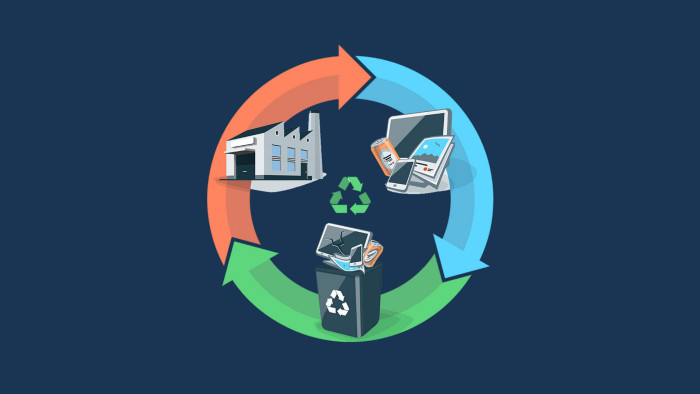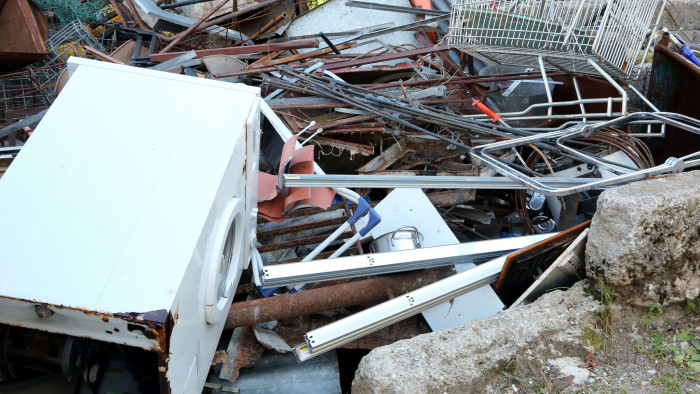The case for a circular world

Roula Khalaf, Editor of the FT, selects her favourite stories in this weekly newsletter.
An easily forgotten fact about the food we eat, the goods we buy and the packaging surrounding them is the demand it places on the natural world. “To produce all of this stuff we need to pull resources out of nature,” notes sustainability expert Leyla Acaroglu in a video she recently produced for Finnish high school students. And, she adds, everything we take out of nature, “is at a cost — it’s just a cost to the future”.
Costs range from the loss of carbon sequestration through deforestation, to the depletion of marine food sources because of plastic waste. Ms Acaroglu, a winner of the UN’s Champions of the Earth award, is one of a growing number of activists who want to reverse these losses through the circular economy. This is an approach to industrial and consumption systems that shifts from linear “take-make-dispose” models to circular ones that return what comes from nature to the production cycle.
This means going back to the drawing board. For example, Steelcase, the US office furniture maker, designs products with disassembly in mind. The company chooses materials that are durable during a product’s lifetime but that can also be recycled. It does not blend materials, since this hampers recycling.
“It’s different to sustainability because essentially we’re trying to, by design, keep things in the system as opposed to just reducing their negative impact,” says Andrew Morlet, chief executive of the Ellen MacArthur Foundation, which advocates for a circular economy.
The idea behind the circular economy predates the term itself. In 2002, for example, Michael Braungart, the German chemist, and William McDonough, the US architect, started promoting similar ideas in their book Cradle to Cradle: Remaking the Way We Make Things.
In 2005, the UK’s National Industrial Symbiosis Programme was set up to help companies from different sectors discover how others might turn their waste into valuable, reusable or marketable resources.
Implementing the principles of the circular economy at a scale needed to tackle climate change and global resource scarcity will not be easy. Given the systems and financial mechanisms that have evolved to support the linear economy, dislodging it will require action by governments, companies, investors, consumers and others.
Manufacturing and industrial sectors play a key role in pushing for change. For some companies, this has meant rethinking the business model. This was the case for Umicore, the Belgium-based materials technology group, which from the 1990s started making the shift from mining operations to a business in refining, recycling and recovering speciality metals.
“It’s been a 100 per cent rejuvenation of the portfolio,” says Marc Grynberg, Umicore’s chief executive. “We moved away from commodity-type activities to invest massively in new technologies.”

For DSM, a life sciences and materials sciences group that has long been working to integrate circular models into its operations, one approach has been to explore different lines of business that offer potential for recycling and reuse. It is currently looking at how to recycle and reuse 100 per cent of carpets by making them from a single type of material, rather than from multiple materials.
“We said let’s go back to the beginning and redesign the carpet,” says Dimitri de Vreeze, a member of DSM’s managing board who is responsible for the company’s materials businesses. “And if it exists in one material, you just take the carpet back and put it into a machine where it is reworked and recycled — that’s what we call true circular.”
When it comes to consumer goods, there has been much discussion about what individuals can do to recycle and reuse waste, whether it takes the form of food, clothing or packaging.
Yet individuals can only do so much, says Peter Freedman, managing director of the Consumer Goods Forum, an international industry body. “With plastic waste, a huge amount is in the hands of industry,” he says. “We can reduce the amount of plastic around products by using paper and having loose products.”
While companies can incentivise consumers to return high-value items such as mobile phones, persuading them to adopt a circular approach to low-priced goods is harder, unless businesses can develop easy solutions such as refillable containers for cleaning fluids or beauty products.
However, mounting consumer pressure may prompt change anyway. “People are frustrated by the extent of packaging and by having to throw a washing machine out after three years,” says Mr Morlet. “Companies are responding — that’s a big shift.”
But, just as consumers can do only so much without action from companies, so companies are looking to government for regulations that reward those embracing the circular economy and create economic incentives to recycle.
“When the cost of reclaiming is higher than the value of the metals to be recovered, there may not be an economic incentive to reclaim, recycle and reuse,” says Mr Grynberg. “That’s where regulation is most needed.”
Most companies developed supply chains for delivery, not recovery. This means that those pursuing circular strategies will need to create infrastructure that supports “reverse logistics”, for which they may have to turn to capital markets for funding.
At the same time, investors with large shareholdings can exert the pressure needed to push companies into embracing circular practices.
Investor interest is certainly growing. In October, BlackRock, the world’s largest asset manager, launched a fund seeded with $20m of its own money to buy stocks that could benefit from the circular economy.

However, while applying ESG (environmental, social and governance) screens to investment decisions is becoming mainstream, many investors have yet to fully understand the circular economy.
“There is a lot of interest,” says Hans Stegeman, head of investment analysis and economics at Triodos Investment Management. “But a lot of investors don’t know where to start because it’s not a sector or a product.”
Also, he adds, not everyone agrees on the definition of what is a circular business model. “You could say Airbnb and Spotify could be circular — but that would not be my approach,” he says.
However, Mr Stegeman argues that as more investors look for both environmental and financial returns from their investments, focusing on companies in the circular economy is the next step.
Given the vast sums of money in global capital markets, investors could form a powerful influence in shifting the corporate sector in a circular direction. “They could be and should be,” he says.
Comments